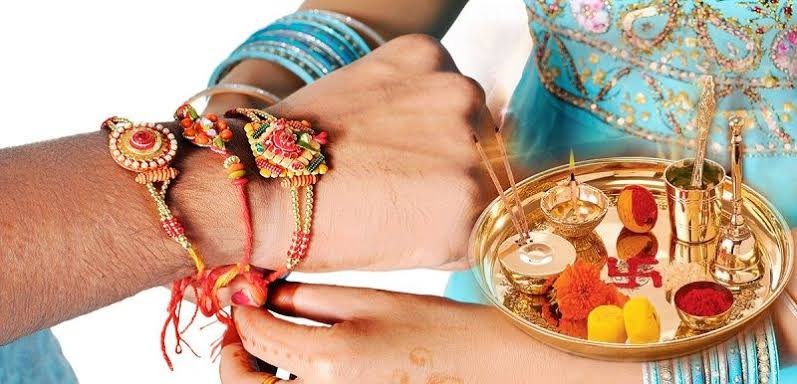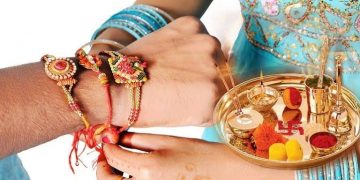Ramesh Sarraf Dhamora

India is a country where people keep celebrating festivals throughout the year. Among them, the festival of Rakhi holds a very special place in the hearts of people. In comparison to all other festivals, Raksha Bandhan is a festival to express and show the importance of a different relationship. Be it children or elders, everyone keeps celebrating it in a memorable way year after year for the special relationship with their brother or sister. The festival of Raksha Bandhan has been showing the sacred affection between brother and sister for centuries. Raksha Bandhan means the bond of protection. While tying the Raksha Sutra in all the religious rituals of Hinduism, the Pandit recites a shloka in Sanskrit. In which the relation of Raksha Bandhan with King Bali is clearly visible.
This shloka is the desired mantra of Raksha Bandhan. Yen baddho Bali Raja Danavendra Mahabalah Ten tvam kathitnaami raksha machal machalah The meaning of this shloka is that I tie you with the same thread with which the great powerful Danavendra King Bali was tied. You should never deviate from your resolve. The holy festival of Raksha Bandhan is celebrated with great pomp in India. It is considered to be a festival that increases sweetness, trust and love in relationships. On this day, sisters tie a rakhi on the brother’s wrist and wish for his long life. During this, the brother also promises to protect his sister and gives her gifts according to his capacity. The festival of Raksha Bandhan is a major festival of the country, a symbol of brother-sister affection. It is also called Shravani festival because it is celebrated on the full moon day of Shravan month.
On this day, rakhi is also tied by Brahmin and Guru. Raksha Bandhan festival has been a cultural measure of social and family unity. This festival is also used as a bond between different sections of society. No one knows when the festival of Raksha Bandhan started. But this festival is mentioned in Bhavishya Purana. When the war between the gods and demons started, the demons started dominating the gods. Devraj Indra, frightened, asked for help from Brihaspati, the Guru of the gods. Indrani, Indra’s wife, sitting there, was listening to everything. She purified the silk thread with the power of mantras and tied it on her husband’s hand. Coincidentally, it was the day of Shravan Purnima. People believe that Indra was victorious in this battle only due to the mantra power of this thread. From that day onwards, the practice of tying this thread on the day of Shravan Purnima has been going on.
This thread is considered fully capable of giving wealth, power, happiness and victory. It is said in an episode of refusal, King Bali donated three steps of land. God measured the entire sky, underworld and earth in three steps and sent King Bali to the underworld. It is said that in the underworld, King Bali took a promise from Lord Vishnu on the strength of his devotion to stay in front of him day and night. Narad ji told Lakshmi ji a solution to the problem of God not returning home. Following that solution, Lakshmi ji went to King Bali, tied Rakshabandhan on him and made him her brother and brought her husband Lord Vishnu with her. That day was the full moon day of Shravan month. Vishnu Purana that on the day of Shravan Purnima, Lord Vishnu incarnated as Hayagriva and got the Vedas back for Brahma. Hayagriva is considered a symbol of knowledge and wisdom. In the Mahabharata itself, there is another story of Krishna and Draupadi related to Raksha Bandhan. When Krishna killed Shishupal with Sudarshan Chakra, his index finger got hurt. Draupadi tore her sari at that time and bandaged his finger. It was the full moon day of Shravan month.
Krishna later repaid this favor by extending her sari at the time of disrobing. It is said that the feeling of mutual protection and cooperation started from here in the festival of Raksha Bandhan. It is also mentioned in the Mahabharata that when Yudhishthira asked Lord Krishna that how can I overcome all the troubles. Then Lord Krishna advised to celebrate the festival of Rakhi to protect him and his army. He said that this silk thread of Rakhi has the power by which you can get rid of every calamity. At this time, there are many references of Draupadi tying Rakhi to Krishna and Kunti tying Rakhi to Abhimanyu.
The story of Raksha Bandhan is mentioned in Skandh Purana, Padma Purana and Shrimad Bhagwat in the story called Vamanavatar. When the demon king Bali tried to snatch the kingdom of heaven after completing 100 yagyas, Indra and other gods prayed to Lord Vishnu. Then Lord Vishnu took the form of Vaman and disguised himself as a Brahmin and went to ask for alms from King Bali. Despite the Guru’s In Uttaranchal, it is called Shravani. Brahmins take dakshina by giving their patrons Yajnaopveet and Rakhi. The very famous religious pilgrimage of Amarnath starts from Guru Purnima and ends on the day of Raksha Bandhan. It is said that the Himani Shivling here attains its full size on this day. On this occasion, a fair is also organized every year in the Amarnath cave. In the hilly areas of Nepal, Raksha Bandhan is tied by the hands of the Guru in the Brahmin and Kshatriya community. But the Indian-origin Nepalese living in the southern border get the Rakhi tied by their sisters like Indians. In Maharashtra, this festival is famous by the name of Nariyal Purnima or Shravani.
On this day people go to the banks of the river or the sea and change their sacred thread and worship the sea. In Rajasthan, there is a custom of tying Ram Rakhi and Chudarakh or Lumba. Ram Rakhi is different from the normal Rakhi. It has a yellow dotted tassel on the red thread. It is tied only to the Lord. Chuda Rakhi is tied on the bangles of Bhabhis. When Rajput warriors used to go to war with the enemy, women used to apply kumkum tilak on their foreheads and also tie a silk thread on their hands. With the belief that this thread will bring them back with victory. Raksha Bandhan is a symbol of brother-sister love. Indian culture is so flexible that every culture gets absorbed in it. From Kashmir to Kanyakumari, from Saurashtra to Assam, if you look here, you will find people celebrating some festival or the other every day. At the core of these festivals is the feeling of adding sweetness and liveliness to mutual relationships. Love, pleading and quarreling between brother and sister is a common thing. But the Raksha Sutra tied by the sister on the brother’s hand on the day of Raksha Bandhan is threaded with the sister’s immense love for the brother and the brother’s sense of duty towards the sister. Nobel Prize winning poet Rabindranath Tagore encouraged the celebration of this festival in 1905 to protest against the partition of Bengal. He wanted to create a strong bond between different communities through this festival. He encouraged Hindus and Muslims to tie Rakhi on each other’s hands, which is a symbol of brotherhood and love for one’s own community. The celebration of this festival was a powerful effort against the British rulers and the partition of Bengal and the differences between Hindus and Muslims.
(The author is a freelance journalist accredited with the Government of Rajasthan.) Mob-9414255034




















